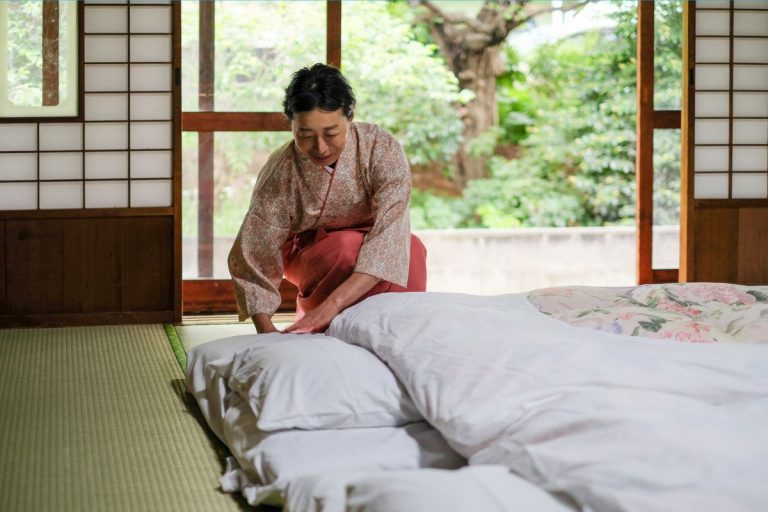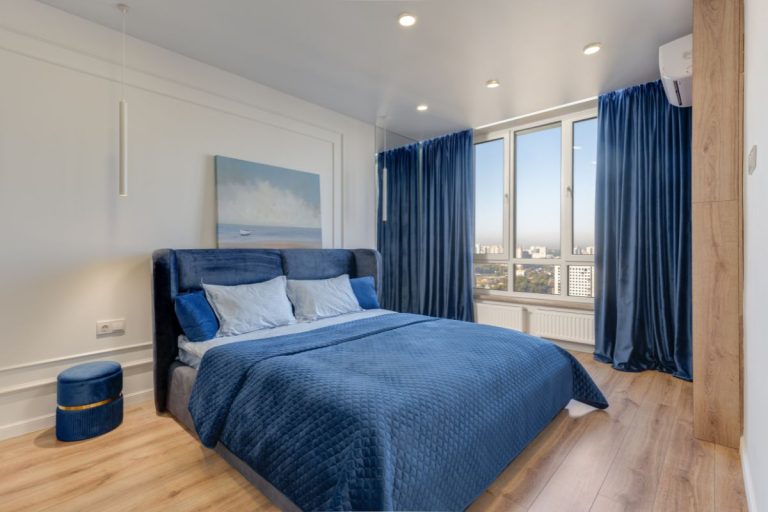Japanese culture is by far one of the fascinating ones. Japanese are famous for their common sense and their appetite for cleanliness, minimalism, and conservative lifestyle.
However, the uniqueness of this society is their inspiring way to design their homes.
Japanese bedrooms have a particular design, often created using natural materials that can somehow recreate the vibe of nature. All the Japanese sleeping areas have this unique warmth and color pleasing to the human eye.
Furthermore, most Japanese bedrooms have this Zen feel and are not designed to feature too many storing areas. Many feature some sliding doors and small courtyard-like rooms to nicely connect to the rest of the home and get some fresh air.
Particular Elements Of Japanese Rooms
Japanese bedrooms got their reputation mainly for their distinctive elements. Most of them follow simple lines, and they are genuinely minimalist. Here are some of the most typical Japanese bedroom trademarks:
Japanese Bedrooms are small
Although some would say that this statement is partially true, let me tell you that the Japanese bedrooms are usually tiny.
Even the largest houses in the country follow this rule. However, the bedrooms are small when it comes to Japanese homes, but most of the spaces are so.
Unfussy Decorations
While some of the Japanese bedrooms are not truly minimalist, they still have little decorations.
These elements are straightforward, compared to the western world, where people tend to get their rooms crowded. A bed, a plant, maybe a simple picture, and that’s all.
Declutter is a must
Without any doubt, Japanese bedrooms are the most inherently relaxing rooms. This means useless things are banned.
To relax and enjoy the space, the area needs to be appealing. As such, one of the golden rules in Japanese culture is decluttering once in a while.
Once you enter a Japanese room, you won’t find anything that seems unnecessary taking up space.
Nothing that should not belong to a bedroom is present in this space. The Japanese bedroom is the ideal space for functionality. This is a breathing room, the area for tranquility and retreat.
Less is more
When designing a Japanese bedroom, you don’t need too many prints or knick knacks. A traditional Asiatic room is nothing more than a place to sleep and to hang out—the fewer elements, the more space for you to relax.
Tiny plants, few lightning items, and a good mattress would be enough to complete the Japanese room.
Best Japanese Bedrooms Design Ideas
This Japanese word for their design elements refers to both sophisticated and straightforward elements with no extraneous parts.
The term is “shibui,” and it is often used to describe the elegance and refinement of taste that represent Japanese homes.
Once seeing the Japanese homes, it is not hard to imagine that kind of typical restraint that leads to some of the most beautiful, celebrated rooms in the world.
Although that austere minimalist style of Japanese bedrooms is not in everyone’s taste, you cannot deny the beauty of these rooms. Let’s discover together the main designs of Japanese sleeping spaces.
Tatami Mats
When it comes to Japanese bedrooms, you should start designing the space from the bottom up.
As you already know, in Japanese homes, you should avoid wearing footwear of any kind, especially in the bedrooms.
As such, to make your barefoot as comfortable as possible, Japanese bedrooms are usually beautifully covered in Tatami mats.
These Tatami mats are all made out of natural materials, meaning processed rice straw, all organic.
Although they seem so thin and light, Tatami mats are incredibly soft, and once you simply walk on the surface of them, you will feel like connecting with the Earth.
The only downside to the Tatami mats is that they are pretty expensive. Considering they are made of natural materials, these comfortable mats do come at a price.
However, covering your bedroom with these elements is a delight. Make sure you do this process from wall to wall.
If the price is an inconvenience, you can opt for some smaller Tatami mats and cut their size to cover the areas you are interested in.
For instance, you can place these mats all around the bed area, so when you go down from your bed, your feet will be spoiled.
Personal opinion: Need a place to start looking? Here is one of my favorite Tamati mats.
Neutral Walls Bedrooms
Speaking of Japanese bedrooms, it is essential to specify the keywords that describe the thematic of these spaces.
One of them is relaxation, as well as calm. When decorating your sleeping area by following this culture’s principles, make sure you focus on colors or patterned wallpapers.
Walls are usually done in earthen colors, very neutral, that should open and lighten up the room.
The preferable colors are light grey, beige, creams, or off-white. However, some would feel like needing more; they can choose some darker colors, such as grey or brown shades, even black if they are braver.
If you want to break the monotony of the room somehow, don’t hesitate to apply some monochrome or little-colored murals. This way, you will add some focal points in the rooms without ruining the whole design.
Some of the most beautiful Japan-inspired motives could be cherry blossoms, bamboo branches, even bonsai leaves.
Create Contrast in the Japanese Bedroom
If you have met the principle of Yin and Yang, you might already know that there is life and living in any aspect of Japanese life.
These two opposites are working together so they can create a whole. Put in this rule to the interior designs as well.
One of the easiest ways to do that is by creating contrasts in the Japanese bedroom.
The black and white difference is the most common one; I recommend setting off the light walls and the furniture with black furniture elements.
On the other hand, if you prefer the furniture in light colors, choose to blend in the light scheme with dark contrasting upholstery or bedding.
However, some of you might find the black and white combination a bit monotone, and it is ok. Then what about a bit of splash of color? Traditionally, most people might stick to the light and dark contrast.
But if they wish to introduce some bolder colors in the bedroom, they should choose a group of objects that can cheer up the room’s atmosphere. For instance, you can break up the dual-chrome color scheme with a joyful painting in multiple colors.
On the other hand, you can add a few scatter cushions in some specific shades.
Low Japanese Beds
There are two golden rules for designing a Japanese bedroom, and both are related to the bed’s position.
First of all, Japanese furniture should stay as close to the floor as possible. Must apply this rule to the bed as well.
Considering this principle, you should forget all those complicated boxsprings, the platform beds, even the four posters.
Try to go for low and simple bed designs. But most importantly, stick to low.
The most traditional Japanese bedrooms don’t even have a bed, but people prefer to place only a mattress directly on the floor surface.
However, if this decision is not your style, then go for the next option and choose some futon bed frames.
Second of all, make sure you won’t place the bed in a corner, as the Western cultures do. If you wish to have a Japanese style bedroom, place your bed right in the center of the room.
Of course, only if you have space for it. If not, try to put the bed right in the middle of the longest wall. This is the ideal compromise whatsoever.
To make the atmosphere even cozier, you may choose to place some bamboo nightstands and some dressers next to the bed. It is only up to you how much furniture you wish to have in the room.
Remember that decluttering is a must, so keep only the bare necessities and not overcrowd the room. Focus on the bed, a possible small dresser, and maybe a seating area too.
Japanese Bedroom with Natural Light
Natural light is an essential part of the Japanese bedroom. As the Zen teaching says, the most comfortable bedrooms have to be completely flooded with lots of light, preferably a natural source.
So if you are planning to have a genuine Japanese-style bedroom, consider the factor of light. Choose the room that comes with the most significant glass fronts or large windows that allow the light to come in.
Once you have the natural light source, place all the furniture and additional elements according to all these light sources.
Nevertheless, if you lack good light, you can invest in some artificial light sources, so the bedroom is all lit up beautifully, even during the darker months and nights.
Choose some paper lanterns or wood-based lamps to make the room look authentic.
Japanese Bedrooms With Sliding Doors
Sliding doors are one of the most famous Japanese elements for interior design.
As I have already mentioned above, natural light is mandatory in the bedroom design style, so patio doors, large windows, or glass fronts are standard in Japanese sleeping areas.
To add some more Japanese coziness and the visual cover, these sliding screens will offer a completely different flair to the rooms. Usually, these sliding doors are made out of paper, usually some shoji screens.
Yet, some would choose the lace-like fabrics used to block out the sought-for natural lighting completely.
Japanese Folding Screens
Folding screens are elegant interior design elements often used to create that sort of privacy or a simple partition off a section in the bedroom.
Since Japanese bedrooms are minimalistic rooms, they should not contain too much furniture but stick to the basics.
However, for some people, the habit of keeping everything minimalistic is quite hard. However, they still need to incorporate a setting area, a make-up corner, a dresser, or a vanity.
Folding screens are an excellent and elegant way to separate the actual sleeping area from all the rooms. These simple elements will smartly hide away your hamper, maybe the dressing table, and so on.
Personal opinion: Here is one of my favorite models.
Carefully Layouts
Every detail in the Japanese room, from the paintings to the Asian-style plants or the bed’s position right in the middle of the room, is essential.
Nothing should be placed accidentally, so make sure you calculate even the smallest detail.
Bring Nature Inside
Although many interior design enthusiasts could not conceive a bedroom without some natural elements in it, well, I want to mention the matching plants anyway.
When it comes to bedrooms that are heavily focused on lots of natural colors and textiles, plants will complete the final atmosphere.
You can use some potted bamboo, even bonsai trees, so that you can bring nature and an additional green layer to the sleeping areas.
Balanced Textures and Colours
One of the most critical aspects of designing a Japanese bedroom is balance. According to Zen emphasis, every single element in the room should be in perfect harmony with the others.
Whether you choose an elaborate or a minimalist design, the most important thing is to take into account the fabrics, patterns, textures, and colors.
In the very best-case scenario, the whole room should look like an organically evolved space, where everything belongs to nature and goes beautifully together.
Organic Fabrics And Textures
Some would be happy with a bedroom that only looks like a Japanese space. However, the Asian-like sleeping area should also feel Japanese.
As such, you should only choose organic fabrics, such as cotton, silk, or linen.
In addition, keep an eye on light colors or unbleached fabrics. Of course, you can add some dark blue accents or Earth shades.
In terms of bedding, make sure the sheets stay neutral, with very natural decorations. Paintings with branches, grass, even flowers, or other plant elements are also a beautiful inspiration.
However, if you love bold colors and need to satisfy this wish, you can simply place some decorative pillows or other textiles with Japanese embroidery.
Minimal accessories
Less is more when it comes to Japanese bedrooms. As such, a Japanese-like bedroom is not the type of space where you can expose expensive artwork, or piles, or lots of decorations.
The style of Japanese bedrooms should stay with minimal accessorizing, with just a few accent items that require special care.
Therefore, keep your attention only on the best pieces of your art collection or a single high-quality item.
Black Words In Frames
One of the typical examples of Japanese wall art is these black words, beautifully framed.
Less is more rings a bell, right? This is how Japanese people guide themselves.
They do not need too much to make the essential things obvious. And when it comes to interior designs, they choose a meaningful word and then write it down on paper or silk.
Then they add a black frame and hang it on the wall. That’s it. However, the final result is impressive and somehow unexpected. As such, for anyone who sleeps in this room, those words would lie low.
Final Touches
These are a few of the most critical elements to consider when designing bedrooms in Japanese style. The gold rule? Less is more. Stick to simple decorations, natural features and always place the bed in the center of the room.
Also Read:





